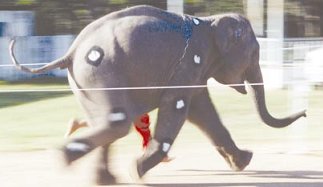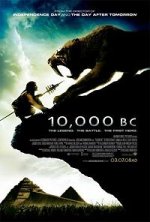Can Elephants Gallop?
I watched 10,000 BC yesterday and was pretty disappointed in the animal animations (which were the main reason I went). Most of them looked rather cheap and computer generated. The most unnatural looking was when the elephants galloped with their back feet moving together. That seemed completely wrong to me but I’m no elephant expert so I took a look at the literature when I got home.
You can see tiny bits of the offending gallop in this preview at around the 40 second and 2 minute mark:
If you can manage to get a glimpse of the mammoths’ movement in that, then compare it to this example:
Luckily there is a Nature paper addressing this issue pretty directly. I think the title “Are fast-moving elephants really running?” is a pretty good give away. If you’re getting published in Nature for determining if an animal runs, it’s pretty unlikely said animal is galloping around.

So the authors (Hutchinson, Famini, Lair and Kram) went to Thailand, got a bunch of elephants, painted motion capture dots on their joints and had the elephants run a 30 meter dash on video camera. You can see a speedy elephant video in their supplementary material. The elephants reached speeds of 25 km/hr. First to take care of the galloping question:

The fastest gait used by elephants has been variously described as a walk, amble, trot, pace, rack or a running walk… …trotting and galloping are running gaits with footfall patterns that are distinct from walking… Our elephants maintained the same walking footfall pattern…
That’s a lot of …’s but I think it gets the point across. Elephants are certainly not galloping. Since that was a little anticlimactic I thought I’d also cover the more interesting question, are elephants running?
The authors first seek to define “running”. Running can be defined as a gait which includes periods where no foot touches the ground and where each foot touches the ground for less than 50% of the time. The second part is new on me but I’m not a kinematicist. It turns out elephants always have at least one foot on the ground but their feet are on the ground only 37% of the time.
Since that didn’t settle the question, the authors turn to physics. The Froude number is a measure of intertia vs gravity often used in boat physics. Apparently scientists also apply it to animals as velocity2/acceleration of gravity/hip height. The authors explain that most animals begin running at at a Froude number of .5 and start to gallop around 2.5. Elephants had Froude numbers as high as 3.4 which seem too high to be a walk.
As a final shot, Hutchinson and his coauthors decided to look at the movement of the center of mass. They explain that in a run the center of mass is lowest at midstride, while in a walk it is highest. Since they couldn’t directly measure the center of mass, the scientists used the position of the elephant’s shoulder and hip to estimate it. Funnily enough, the shoulder and hip were moving in opposite directions with the shoulder indicating walking and the hips indicating running.
So it looks like fast-moving elephants aren’t walking but they’re not really running either. They certainly were not galloping. Which brings us back to the movie 10,000 BC. I can’t understand why they wouldn’t do even rudimentary research (or watch Lord of the Rings which if I remember right got the gait correct) into the movement of animals filling such a central role in the movie. The galloping mammoths look completely fake even without knowing anything about elephants. But I guess with the general lack of concern for history, it’s not too surprising they wouldn’t worry too much about accurate biology either.
Reference
Hutchinson, J.R., Famini, D., Lair, R., Kram, R. (2003). Biomechanics: Are fast-moving elephants really running?. Nature, 422(6931), 493-494. DOI: 10.1038/422493a
